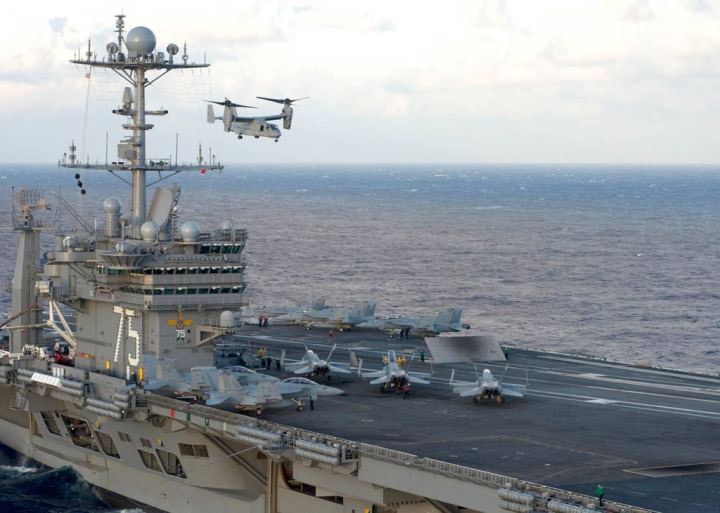Navy 2016 Budget Funds V-22 COD Buy, Carrier Refuel
Posted on
PENTAGON: The Navy 2016 budget yields to Congress’s strong opposition to the service’s previous efforts to cut the active fleet to save money. It funds nuclear refueling and overhaul of the aircraft carrier USS George Washington –that it had tried to retire — and modifies its plan to put 11 cruisers and an amphibious ship into a deferred modernization program.
The Navy’s top budget officer, Rear Adm. William Lescher, said the plan now was to put two cruisers a year into a time-limited modernization program, which would still provide 11 updated ships for the future, but limit the drop in deployable cruisers.
Those changes would preserve the 11-carrier fleet and increase the operational fleet from the current 279 ships to 304 in 2020.
Also, as Breaking Defense readers already knew, the budget request confirms that the service will begin buying a version of the tilt-rotor V-22 Osprey to replace the fixed-wing C-2 as its carrier-onboard-deliver (COD) aircraft. It would buy eight Ospreys a year from 2018 to 2020. That is a win for the Bell-Boeing team that makes V-22s over Northrop, which built the C-2s, and Lockheed Martin, which proposed a modified version of its old S-3 Vikings.
The Navy’s top research and development programs are for the Ohio Replacement Program replacement for the next generation of ballistic missile submarines slated to get $1.5 billion this year and $5 billion over the next five years. The Navy still hopes construction funding, starting in FY2021, would come from a separate fund.
The $161 billion base budget request is $12.9 billion over the caps imposed by sequestration and would be an $11.3 billion jump over the current year’s base budget, reversing a three-year decline in funding. The request for overseas contingency operations (OCO) funding, which is not restricted by the budget caps, would give the Navy and Marines a total of $168 billion.
The service’s budget boost will pay mainly to improve ship and aircraft maintenance, as well as sailing and flying hours and to stop the decline in Navy and Marine personnel. There are only minor increases in procurement, with the Navy continuing construction of one amphibious ship that Congress had added in the current defense funding. The Navy also added two of the carrier-capable F-35C fighters and one P-8A patrol plane over the previous projection. The Marines would get most of the seven RQ-21 Blackjack UAVs that were added to the procurement request.
For other ship procurement, the budget would pay for nine – continuing two-a-year plans for Arleigh Burke destroyers and Virginia-class attack submarines, three Littoral Combat Ships, the 12th San Antonio-class landing platform ship Congress initiated last year, and the first of the T-AO(X) fleet tanker, although the contract has not been awarded.
The Navy budget would buy a total of 124 aircraft, nine less than the current year, due to the end of buying EA-18G Growler electronic warfare fighters. Of course, Congress may well reverse that decision about the Growler. The budget also would pay for nine Marine F-35Bs; four Navy F-35Cs — two more than planned in the 2015 budget; five E-2D radar warning aircraft; 16 patrol jets, and two Marine KC-130J transport-refuelers, both one more than previously planned; 28 AH-1Z and UH-1Y Marine helos; 19 MV-22s, and 29 Navy MH-60R helicopters.
The service plans to buy 12 drones: two Navy MQ-8C Firescouts, four RQ-21As for the Marines and three for Navy Special Operations Command, and three Navy MQ-4 Tritons.
Subscribe to our newsletter
Promotions, new products and sales. Directly to your inbox.

